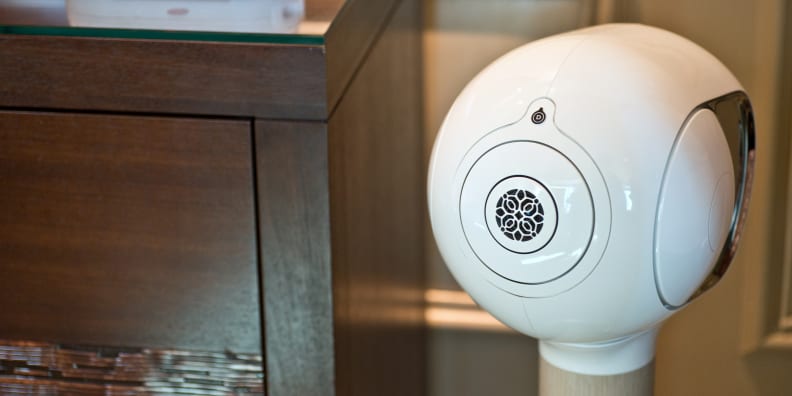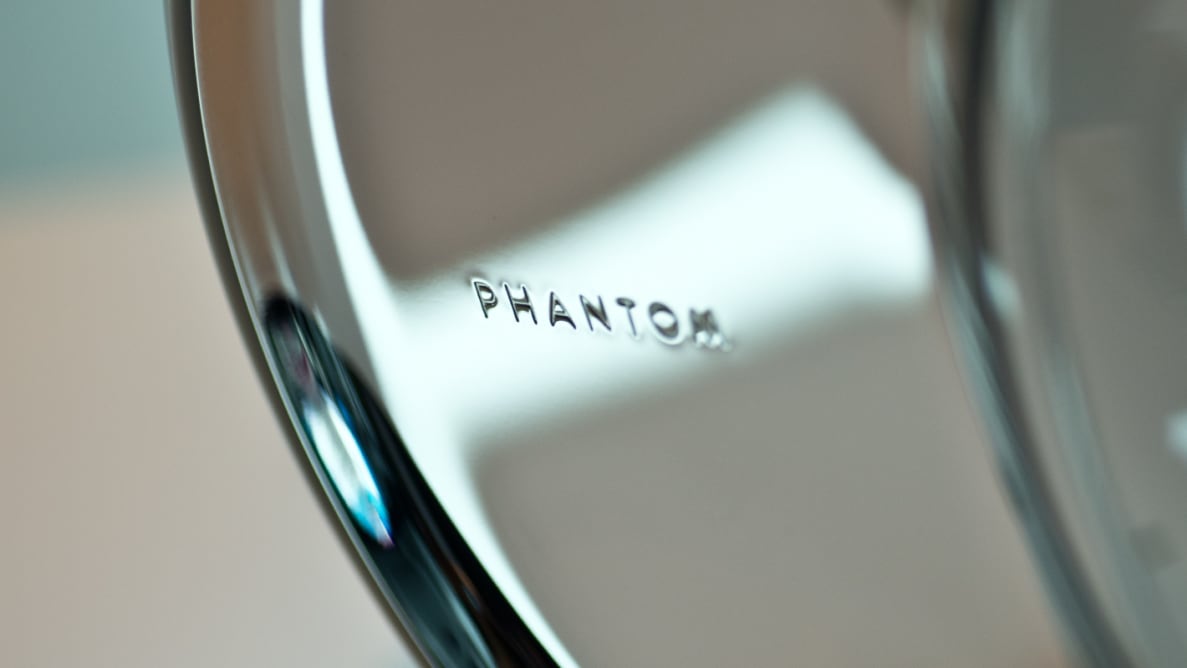In other words, if you sink a bunch of cash into a setup you're not perfectly happy with, you're out of luck unless you can offload it and try again.
To that end, it's not surprising that many audiophiles and cinema geeks dump ungodly amounts of money into their systems. After all, it's an investment in their own happiness, and one they'll need to be happy with for years to come. And because speaker systems in the past have necessitated huge boxes and bundles of cables, a successful marriage of form and function has been rare indeed.
Enter the Devialet Phantom—one of our favorite products at CES this year. Not only does its relatively compact body look unbelievably slick, but its subwoofer design is absolutely revolutionary. We aren't easily floored, but this Phantom is going to haunt us for some time to come.
Design
This was a triumph
Taken at face value, the Devialet Phantom fits right in with some of the more out-there luxury designs we've seen in the past few years. Manufacturers like Bang & Olufsen and Panasonic (with its reborn Technics line) have been churning out stunning if brain-meltingly expensive speaker designs in hopes of capturing the burgeoning high design home theater market.
But while the designs are gorgeous, under the skin most of these super-luxe speakers aren't radically different. It's damn hard to get the visual wow factor luxury spenders want and groundbreaking performance to match.
This is where Devialet stands out from the pack.
To be sure, its Phantom speaker is a fascinating oddity. Honestly, when I first laid eyes on it, there was a brief instant when I was convinced someone had made an honest-to-God Portal gun. Its exterior is clean, sleek, and futuristic in ways that would make any kid of the '80s giddy. Whether you drop it on a stand or on a table, it's absolutely bonkers how photogenic this design is—whether you get the 3,000-watt silver or 750-watt all-white model.
But the Phantom's strange, semi-spherical design isn't just for show; it's a rare case of form following function.

Put the Phantom on a stand, and you can link up to 23 other Phantoms.
When it's playing music, the Phantom is a sight to see. Those two circular domes are actually a new type of subwoofer developed by Devialet, and when you crank the volume, they pulse in and out of the pod. I tried to capture the effect using pictures and video, but the effect is so intense that the shutter couldn't keep up. It's spectacular.
Like many post-Sonos high-end setups, the Phantom can operate over a WiFi network created by a small, easily-concealable audio router called the Dialog. Most systems can operate over your standard household WiFi router, but the Dialog goes above and beyond, linking up to 24 Phantom speakers scattered throughout a house. (We have concerns about what that might do to your home's foundation, and your bank account, if your parties get really bumpin'.)
How do you control your armada of spaceship-lookin' speakers? Through Devialet's Spark app. Compatible with iOS, Android, Mac OS X, Windows 7 and up, you can view your entire catalog of media from an array of sources, then play it wherever you want. If you're hosting an audiophile soirée, anybody with the Spark app can push music to a shared playlist. That takes a lot of the prep work off of your hands. You can also yank songs off of a friend's device if they're too busy chatting someone else up to dig out their phone.
Thanks to the speaker's wireless design, cables are reduced to nothing more than a simple power cord. One cable is easy to conceal, so you won't have a rat's nest of RCA, 1/4-inch, or 1/8-inch cables stashed behind your entertainment center.
Under the Hood
I'm making a note here: "Huge success."
We probably never would have paid the Phantom any mind if we hadn't heard super bassy music blasting over the din of a crowded press event at the MGM Grand. Audio quality is near-impossible to gauge at a trade show, but walking by the Devialet booth stopped us dead in our tracks.
The speaker, no bigger than a basketball, was cranking out tunes with a 750-watt power source, and it sounded fantastic.

The exterior of the Phantom looks like a Portal gun.
So we looked deeper, and the guys at the Devialet booth handed us a white paper on the audio technology behind the speaker. Digging through the sales-speak, we sussed out the fascinating underlying science. This speaker relies on a mix of creative processing and physics tricks to cram an absolutely unbelievable amount of power into a tiny package. Seriously: The numbers are incredible to the point of ridiculousness.
At the heart of the Devialet Phantom are two main technological breakthroughs: What the company calls "Heart Bass Implosion" subs (more on that later), and the miniaturization of an analog/digital hybrid (ADH) amplifier. For those following along at home, hang on: This is about to get technical.
The ADH splits the load (ha) between two separate processing parts—the analog (class A) amp handles modulating the output voltage, while the digital (class D) amp component is responsible for most of the current. Where analog amps are typically huge, the ADH system means high power, low size. In fact, the whole ASIC running the show is crammed into a chip that's 1cm2 with 5 1µm-thick layers.
It's a best-of-both-worlds scenario, especially when backed up by a legendary digital-to-analog processor chip (DAC) like the Phantom's Texas Instruments PCM1798 (24-bit/192kHz). In order to handle many of the higher-level processing functions like the Speaker Active Matching, the Phantom also packs an 800MHz dual-core ARM Cortex processor along with 512MB of RAM.

Imagine a world without wires—inside and out.
Impressively, the Phantom does all this without using a single internal wire. No jump elements, no cables, nothing. Every connection necessary is handled by boards and other components. That's unheard-of for speakers, and a testament to how thoroughly Devialet has designed its product, inside and out.
Now for those subs—those unbelievable subs. Traditionally, subwoofers responsible for the lowest audio frequencies need to have a large-diameter driver in order to move enough air to create the desired sounds. No matter how you do that, there are drawbacks.
Designs with vents are susceptible to sound pressure cancelation in super low-frequency sound, while sealed-box units—while better at playing low-frequency notes—have enormous difficulty moving air in the volumes necessary to bump bass at a desirable level. It takes a huge amount of power behind super big drivers to get a decent sound pressure level for music listening with this method.
Defying Physics
It's hard to overstate my satisfaction.
I'm going to level with you, that Portal reference earlier wasn't too far off the mark—this product seems to defy physics. Reading the white paper and the spec sheet, it's tough to wrap your brain around the sheer force created by the two subs in the Phantom.
Devialet doesn't use either of the aforementioned subwoofer designs. Instead, it uses a modified version of the sealed-box design where the drivers fire into the unit's hemispheric resonance chamber (which takes 1.2 tons of compression force to seal, by the way).
Because it's blasting a speaker each into only 3 liters of air, the sound pressure in each chamber reaches levels which Devialet claims to exceed 174dB. That's roughly the sound pressure level of a rocket firing from 1 meter away, and 20 times the pressure inside the typical sealed-box subwoofer.
If that's not impressive enough for you, each subwoofer is capable of moving a mass of 66 pounds (30kg) while playing. Your current home theater system ain't doing that anytime soon.

An inside view of what Devialet calls the Heart Bass Implosion subwoofers.
Normally, it would take massive drivers with equally crazy power behind them to achieve this feat, but the Phantoms have another trick up their sleeve: increased diaphragm travel. You can see this in videos of the unit—each element moves out of the sealed housing at blistering speeds, and with significant travel. Because each driver can move farther than competing components, the amount of air pushed by the element is much greater, meaning high power in a sealed chamber.
Speaking of that chamber, Devialet's crazy engineering goes even deeper inside the Phantom. The last bit is the housing's semi-spherical design. Sound waves are compression waves, moving outward through a medium (usually air) in a spherical fashion. As such, traditional box-shaped speakers will bounce sound around in weird ways, introducing diffraction. A spherical chamber mitigates this effect, and that's what's used in the Devialet Phantom.
Conclusion
Anyway, these speakers are great.
At the end of the day, all this technobabble means one thing: These are some of the best-designed speakers known to man—for the time being, anyway.
These are the luxury speakers you should buy when you have the money to spend and you want something that sounds as amazing as it looks. While we can't give you lab-tested data on this speaker after a CES show floor demo, it's clear to hear that the Phantom is special.

A small midrange driver lives in the front.
Good design is a marriage of form and function; I don't think I've ever seen a complex instrument fit the bill better than the Devialet Phantom. But even if they were the most hideous audio equipment ever made, the internal design would still be impressive enough to earn our editors' attention. That's why it took home an Editor's Choice Award for CES 2015. It's just gravy that good design permeates every single aspect of the Phantom's construction.
Audiophiles in the EU can pre-order now, with shipping set to begin on February 15. The Phantom will be, well, a phantom in the U.S. for the near future, but American pricing has been set at $1,990 for the 750-watt variant and $2,390 for the 3,000-watt. You'll also need to pick up the $329 Dialog WiFi box to start building your system. Obviously, that's a huge commitment.
Still, it's good to see that insane technology like this is actually coming down in price. Back in 2010, for example, the amplifier technology in the Phantom retailed for $15,995 in Devialet's D-Premier Amplifier. You're not going to see Phantom-like speakers at Best Buy any time soon, but at least they're no longer an unattainable dream.
They're very real, and very awesome.
Meet the tester
A seasoned writer and professional photographer, Chris reviews cameras, headphones, smartphones, laptops, and lenses. Educated in Political Science and Linguistics, Chris can often be found building a robot army, snowboarding, or getting ink.
Checking our work.
Our team is here for one purpose: to help you buy the best stuff and love what you own. Our writers, editors, and lab technicians obsess over the products we cover to make sure you're confident and satisfied. Have a different opinion about something we recommend? Email us and we'll compare notes.
Shoot us an email


